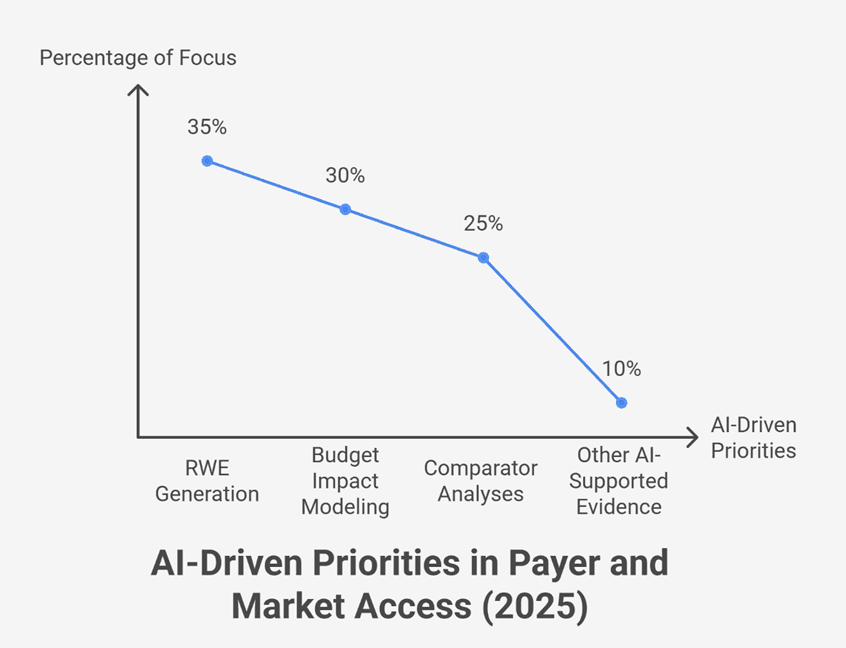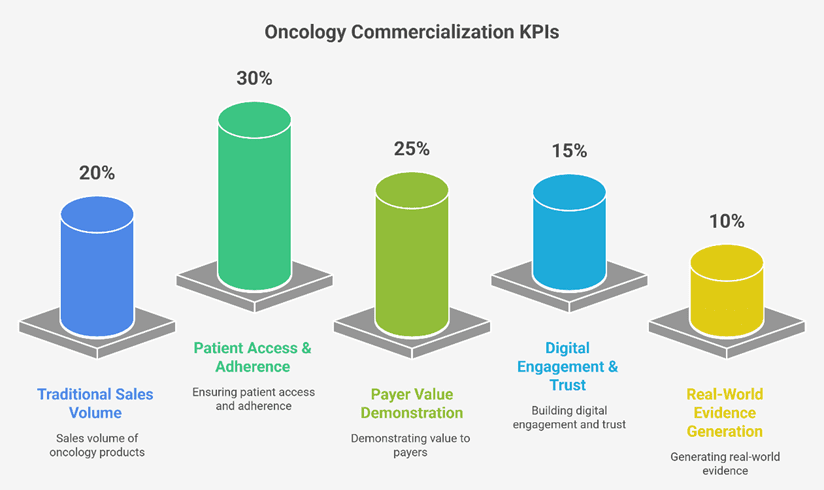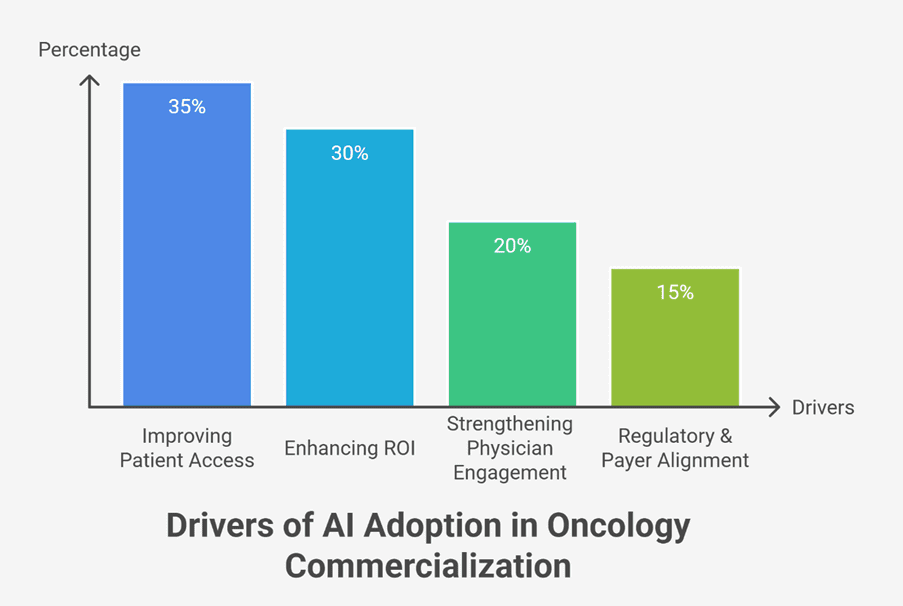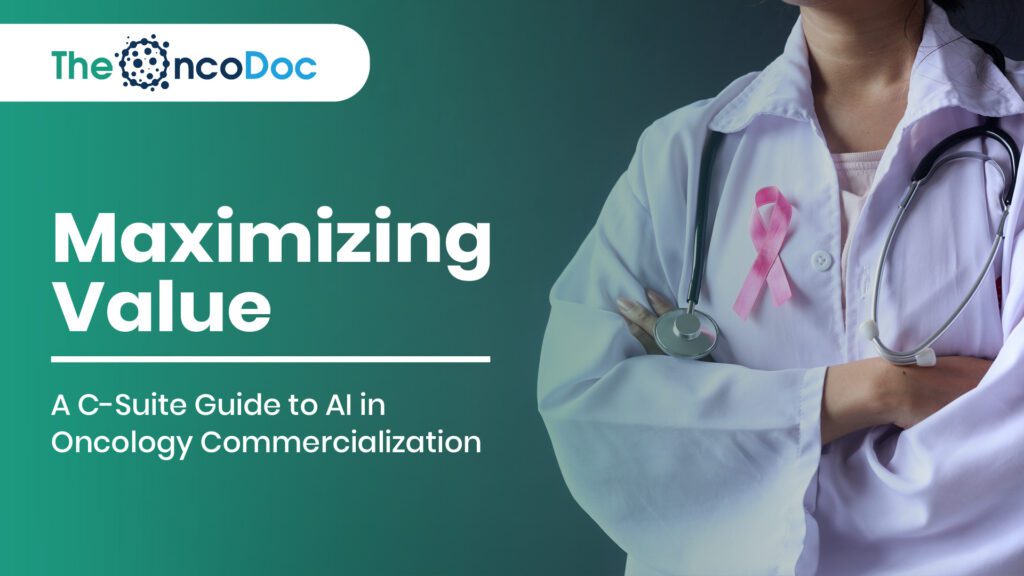Introduction: Redefining Oncology Commercialization with AI
The commercialization of oncology therapies is no longer defined by sales volume alone, it is defined by the value delivered across the patient, physician, and healthcare ecosystem. As oncology becomes increasingly complex, with precision medicine, immunotherapies, and genomic-based treatments at the forefront, the C-Suite must integrate AI not as a tool, but as a strategic driver of value creation.
Artificial Intelligence (AI) in oncology is not just transforming research and development but also revolutionizing commercialization pathways: patient engagement, physician decision support, payer negotiations, and outcome tracking. The executive leadership of pharma companies must now adopt a dual lens: maximizing shareholder returns while ensuring patient access, affordability, and trust.
This article provides a C-Suite guide to maximizing value in oncology commercialization through AI, structured across strategies, execution levers, and future trends.
1. Why AI is a C-Suite Imperative in Oncology
Executives can no longer view AI as a “support function.” It is a boardroom agenda item that drives competitive advantage.
Key imperatives include:
- Revenue Growth – AI-enabled segmentation improves precision targeting, raising conversion rates for new therapies.
- Cost Optimization – Predictive analytics reduce wasted spend in marketing campaigns and streamline salesforce effectiveness.
- Market Differentiation – AI-powered personalization builds trust in oncology, where patient fear and misinformation remain high.
- Regulatory Alignment – AI-driven real-world evidence (RWE) strengthens negotiation with payers and regulators.
- Patient-Centricity – Hyper-personalized digital touchpoints ensure that commercialization aligns with unmet patient needs.
2. From R&D to ROI: How AI Extends Commercial Lifecycles
Traditionally, oncology drugs face short market exclusivity windows due to patent cliffs and rising biosimilar threats. AI maximizes lifecycle value by:
- Mapping unmet patient cohorts through real-world data (EHRs, genomic datasets).
- Supporting label expansions based on predictive modeling of cross-indication potential.
- Identifying early signals of resistance or relapse, creating new lines of therapy opportunities.
For the C-Suite, this ensures longer commercial durability and improved ROI.
3. AI-Driven Patient Segmentation and Access
AI provides granular patient archetypes that extend beyond demographics. Segmentation now considers:
- Genomic signatures – Predicting therapy suitability.
- Digital behavior – Online searches, app engagement, or wearable usage.
- Psychosocial drivers – Fear, stigma, or financial constraints that impact adoption.
Strategic Outcome: Tailored patient access programs that increase initiation and adherence rates.
4. Physician Engagement: Precision Marketing for Oncologists
Oncologists face information overload with rapidly evolving therapies. AI simplifies engagement by:
- Delivering custom dashboards summarizing trial updates relevant to their patient mix.
- Prioritizing predictive referral networks, identifying GPs most likely to encounter early cancer symptoms.
- Automating content personalization, ensuring oncologists receive updates in their preferred channel (mobile, CME modules, or peer case libraries).
This precision reduces marketing waste and strengthens brand loyalty at the physician level.
5. Payer and Market Access Strategies with AI
C-Suite leaders recognize that payer negotiations dictate commercialization success. AI strengthens value demonstration through:
- RWE generation – Linking therapy outcomes to healthcare cost savings.
- Budget impact modeling – Predicting long-term cost offsets from early cancer detection.
- Comparator analyses – Benchmarking against existing standards of care.
This allows executives to justify premium pricing while proving affordability in strained healthcare systems.

6. AI in Patient Awareness and Behavioral Nudging
Patients today are active participants in oncology decisions. AI-enabled campaigns:
- Deploy chatbots for symptom triage and consultation guidance.
- Personalize nudges (reminders for mammograms, colonoscopy scheduling).
- Counter misinformation by real-time monitoring of social media and deploying verified expert interventions.
This creates trust loops where patients perceive the brand as a partner, not just a seller.
7. AI for Global and Local Market Expansion
Pharma executives balancing global commercialization goals must adapt to local oncology realities. AI-driven hyperlocalization ensures:
- In rural India, campaigns on oral cancer leverage WhatsApp-based education.
- In European markets, genomic-driven risk models guide high-value precision therapies.
- In Asia-Pacific, voice-first interventions overcome literacy barriers.
This glocal strategy maximizes reach without diluting brand integrity.
8. Data Integration: Building an AI-Powered Commercial Ecosystem
Executives must invest in a unified AI-commercialization architecture integrating:
- EHR Data – Identifying eligible patient cohorts.
- Claims Data – Mapping payer burdens and bottlenecks.
- Digital Health Data – Leveraging wearables and patient apps for outcome tracking.
- Social Listening – Detecting misinformation and sentiment shifts.
Such integration provides board-level dashboards for real-time decision-making.
9. KPIs for C-Suite AI Adoption in Oncology
Traditional sales metrics no longer suffice. Executives must adopt value-centric KPIs such as:
- % Increase in early diagnosis referrals.
- Treatment adherence rates via digital nudges.
- Payer coverage expansion success.
- Survivor community engagement levels.
- Incremental ROI from AI-driven campaigns.

10. AI and Trust Building in Oncology Commercialization
Trust remains the most valuable currency in oncology marketing. AI strengthens it by:
- Ensuring transparent data-driven communication with physicians.
- Facilitating patient communities moderated by survivor advocates.
- Enhancing brand authenticity through predictive, empathetic, and patient-first campaigns.
11. Executive-Level Challenges in AI Adoption
C-Suite leaders must navigate:
- Data Privacy Regulations – GDPR, HIPAA compliance.
- Ethical AI Concerns – Avoiding bias in patient targeting.
- Change Management – Aligning salesforces and medical teams with AI-driven insights.
- ROI Justification – Ensuring upfront investment translates into measurable returns.
12. Future Outlook: The AI-First Oncology Commercial Enterprise
The next decade will see:
- AI Digital Twins simulating therapy response for market prediction.
- Outcome-Based Pricing Models tied to AI-monitored real-world survival rates.
- Emotion-Aware Marketing adapting campaigns to patient sentiment.
- Virtual Oncology Marketplaces integrating diagnostics, treatment, and pharma services into a seamless AI-enabled experience.

13. AI in Competitive Intelligence for Oncology
C-Suite leaders face highly competitive oncology landscapes where multiple therapies often compete for similar indications. AI tools enable dynamic market intelligence by:
- Tracking competitor trial updates in real-time.
- Using natural language processing (NLP) to analyze regulatory filings and conference proceedings.
- Identifying white spaces for differentiation in patient support, adherence, or payer models.
- Predicting launch sequencing advantages to time entry into specific markets.
Strategic Value: Executives gain foresight to preempt competitor moves and optimize positioning.
14. AI-Powered Salesforce Effectiveness
Traditional salesforce strategies are resource-heavy and often inefficient. AI maximizes impact through:
- Territory Optimization – Matching sales reps to regions with the highest patient and physician density.
- Call Prioritization – Predicting which oncologists are most likely to adopt a therapy.
- Content Personalization – Delivering micro-learning assets aligned with physician preferences.
- Field Rep Augmentation – Equipping reps with AI-driven dashboards for real-time responses.
Executive ROI: Higher productivity per sales rep and reduced wasted effort.
15. Integrating AI with Real-World Evidence (RWE) Platforms
Oncology commercialization increasingly depends on RWE for payer approval and physician trust. AI enhances this by:
- Cleaning and harmonizing messy EHR datasets.
- Running predictive outcome models based on real-world cohorts.
- Providing survival curve simulations tailored to payer discussions.
- Offering adverse event monitoring that informs both regulators and marketing teams.
This ensures faster market access and strengthens the negotiation position with stakeholders.
16. AI in Value-Based Contracting with Payers
The shift from volume-based sales to value-based reimbursement requires robust data intelligence. AI supports:
- Risk-sharing models that link payment to patient outcomes.
- Predictive adherence analysis to forecast real-world therapy performance.
- Cost-offset modeling that quantifies the economic benefit of early detection.
C-Suite Implication: Executives can confidently enter outcome-based contracts without fear of unpredictable losses.
17. AI in Clinical-to-Commercial Transition
The handoff from clinical development to commercial launch is often inefficient. AI bridges this gap by:
- Mapping trial population data to commercial patient populations.
- Identifying subgroup responders to design targeted launch campaigns.
- Forecasting adoption curves for pricing strategy optimization.
Strategic Gain: Reduced time-to-market and smoother scaling of therapies post-approval.
18. AI in Market Expansion Beyond Tier-1 Cities
Executives often underinvest in Tier-2 and Tier-3 markets, assuming low oncology adoption. AI demonstrates otherwise by:
- Identifying undiagnosed clusters using regional health and digital search data.
- Deploying vernacular voice-first campaigns in rural populations.
- Leveraging community health worker networks with AI-driven educational materials.
This creates new revenue pools while fulfilling corporate social responsibility goals.
19. Ethical AI in Oncology Commercialization
Adopting AI without ethics risks brand credibility. Executives must implement:
- Bias Audits – Ensuring AI models do not exclude minority populations.
- Explainable AI (XAI) – Making predictions transparent to regulators and physicians.
- Consent-Driven Data Use – Respecting patient rights in RWE gathering.
- Equitable Access – Avoiding over-targeting of wealthy urban populations at the expense of rural patients.
Leadership Imperative: Building trust-based commercialization ecosystems.
20. Case Study Insights: Pharma AI Leaders
Executives can learn from pioneers:
- Roche: Using AI to accelerate oncology diagnostics integration with commercial campaigns.
- Novartis: Leveraging predictive analytics for salesforce targeting in breast cancer markets.
- Pfizer: Using AI-driven patient navigation chatbots to support early cancer detection globally.
- AstraZeneca: Embedding AI into omnichannel lung cancer awareness campaigns.
These cases demonstrate that AI is already reshaping oncology commercialization, not a distant vision.
21. Cross-Functional AI Alignment in Pharma Enterprises
C-Suite leaders must break silos. Successful AI adoption requires integration across:
- R&D Teams – feeding clinical trial learnings into commercial strategy.
- Medical Affairs – ensuring scientific integrity in AI-driven physician education.
- Regulatory Affairs – navigating compliance frameworks proactively.
- Commercial Units – operationalizing insights into campaigns.
Outcome: A unified, enterprise-wide AI-first commercialization culture.
22. AI in Survivor Engagement and Long-Term Value Creation
Commercialization does not end at drug adoption. Survivors are brand advocates. AI enables:
- Sentiment monitoring of survivor communities.
- Personalized survivorship care plans delivered via digital apps.
- Peer-moderated virtual groups to build loyalty.
- Longitudinal data tracking for RWE expansion.
This creates sustainable patient-brand relationships and long-term differentiation.
23. C-Suite Roadmap: Implementing AI Commercialization Strategies
For leaders, execution requires structured planning:
- Vision Setting – Align AI adoption with corporate oncology mission.
- Investment Prioritization – Allocate budgets for data infrastructure and AI partnerships.
- Talent Strategy – Build AI-commercial hybrid teams with oncology expertise.
- Governance – Establish AI ethics and compliance frameworks.
- Measurement – Track value-centric KPIs instead of traditional sales metrics.
Executive Takeaway: AI commercialization is not a project, it is a boardroom transformation agenda.
24. Future Horizons: AI and Oncology Market Redefinition
Over the next decade, AI will unlock new commercialization frontiers:
- Digital Twin Markets – simulating therapy adoption in synthetic populations.
- Immersive Metaverse Campaigns – patient and physician education in virtual reality.
- Precision Pricing – dynamic therapy pricing models adjusting to regional affordability.
- AI-Integrated Pharmacies – directly engaging patients with adherence monitoring at dispensing points.
For the C-Suite, this means reimagining commercialization beyond today’s paradigms.
25. AI in Strategic Partnerships and Ecosystem Commercialization
Pharma commercialization in oncology no longer exists in isolation. The C-Suite must recognize that AI thrives in collaborative ecosystems where data, technology, and healthcare converge. Strategic partnerships powered by AI can unlock exponential value:
- Hospitals and Cancer Centers – AI platforms can integrate with oncology care pathways, enabling real-time identification of eligible patients and seamless referrals.
- Technology Giants – Collaborations with AI-first companies (Microsoft, Google, IBM Watson Health) bring computational power and advanced analytics capabilities.
- Startups and Innovators – Oncology-focused healthtech startups provide agile AI models for early diagnosis, patient navigation, and biomarker discovery.
- Payer Partnerships – AI-enabled joint ventures with insurers allow for innovative risk-sharing models, linking reimbursement directly to patient outcomes.
- Government and NGOs – Public-private partnerships enhance screening outreach and create AI-powered national registries for cancer monitoring.
C-Suite Implication: These partnerships create shared-value ecosystems, where commercialization is not only about brand growth but also about advancing national and global oncology outcomes. By positioning their companies as ecosystem orchestrators, executives can secure first-mover advantages in access, trust, and sustainable revenue.
Strategic Outcome: Oncology commercialization evolves from being drug-centric to solution-centric, where pharma companies powered by AI are seen not just as manufacturers, but as healthcare enablers driving long-term patient value.
Conclusion: A C-Suite Call to Action
Oncology commercialization in the AI era is not about pushing therapies, it is about maximizing ecosystem value. For the C-Suite, this requires a strategic pivot from short-term sales to long-term value: aligning patients, physicians, payers, and regulators through transparent, intelligent, and empathetic engagement.
By embedding AI into commercialization strategies, executives can:
- Ensure patient-first access.
- Demonstrate sustainable value to payers.
- Achieve differentiation in crowded oncology markets.
- Secure longer commercial lifecycles for breakthrough therapies.
The future of oncology commercialization belongs to leaders who embrace AI not as a technology, but as a strategic partner in delivering hope, health, and long-term value.
The Oncodoc team is a group of passionate healthcare and marketing professionals dedicated to delivering accurate, engaging, and impactful content. With expertise across medical research, digital strategy, and clinical communication, the team focuses on empowering healthcare professionals and patients alike. Through evidence-based insights and innovative storytelling, Hidoc aims to bridge the gap between medicine and digital engagement, promoting wellness and informed decision-making.



